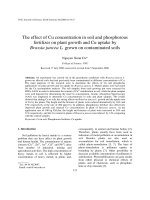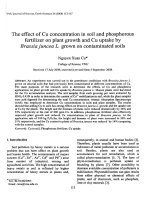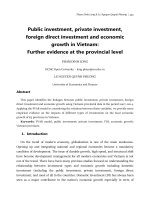Effect of plant geometry and fertilizer levels on yield and economic of cowpea (Vigna unguiculata L. Walp)
Bạn đang xem bản rút gọn của tài liệu. Xem và tải ngay bản đầy đủ của tài liệu tại đây (207.47 KB, 5 trang )
Int.J.Curr.Microbiol.App.Sci (2017) 6(5): 1518-1522
International Journal of Current Microbiology and Applied Sciences
ISSN: 2319-7706 Volume 6 Number 5 (2017) pp. 1518-1522
Journal homepage:
Original Research Article
/>
Effect of Plant Geometry and Fertilizer Levels on Yield and
Economic of Cowpea (Vigna unguiculata L. Walp)
A.R. Jagadale, G.K. Bahure*, I.A.B. Mirza, S.H. Mirche and S.R. Ghungarde
College of Agriculture, Latur V.N.M.K.V., Parbhani – 413512, India
*Corresponding author
ABSTRACT
Keywords
Cowpea,
Levels of
fertilizer,
Spacing yield
and Economic.
Article Info
Accepted:
17 April 2017
Available Online:
10 May 2017
The field investigation entitled “Effect of plant geometry and fertilizer levels on yield and
economicsof cowpea (Vignaunguiculata L. Walp)” was conducted at Department of
Agronomy, College of Agriculture, Latur. The experimental field was levelled and well
drained. The soil was clay loam in texture, low in available nitrogen, very low in available
phosphorus, very high in available potassium and moderately alkaline in reaction. The
environmental conditions prevailed during experimental period was favourable for normal
growth and maturity of cowpea crop. The experimental plot was laid out in a Factorial
Randomized Block design (FRBD) with four spacing and three levels of fertilizer which
comprises twelve treatment combinations. Each experimental unit was repeated three
times. The gross plot size of each experimental unit was 5.4 x 4.5 m2 and net plot size was
4.8 × 3.5 m2(S1), 4.8 × 3.6 m2(S2), 4.5immense
× 3.5 m2(S3), 4.5 × 3.6 m2(S4)respectively.important
Sowing
th
was done on 4 July, 2013 with four spacingviz.30 x 10 cm2 (S1), 30 x 15 cm2(S2), 45 x 10
cm2 (S3), 45 x 15cm2 (S4) and three levels of fertilizerviz.30:60:00 NPK kg ha-1, 25:50:00
NPK kg ha-1 and 20:40:00 NPK kg ha-1 as per treatments. Sowing was done by dibbling
method. Cowpea crop grown in kharif season produced significantly higher seed yield,
straw yield, gross monetary return, net monetary return and benefit cost ratio of cowpea
crop was observed with the wider spacing 45 x 10 cm2. The higher seed yield, straw yield,
gross monetary return, net monetary return and benefit cost ratio was obtained due to
higher fertilizer level i.e. application of 30:60:00 NPK kg ha-1. The interaction effects of
spacing x fertilizer levels were found non-significant.
Introduction
The cowpea (Vigna unguiculata L.walp.)
belongs to family Leguminaceae with
subfamily Papilionaceae. Cowpea is one of
the most ancient crops known to man. Its
origin and subsequent domestication is
associated with pearl millet and sorghum in
Africa. It is a broadly adapted and highly
variable crop cultivated around the world
primarily for seed also as a vegetable, green
pods, fresh shelled green peas and dried peas,
a cover crop and for fodder. Cowpea is of
multipurpose grain legume. The mature
cowpea seed contains 24.8 per cent protein,
63.6 per cent carbohydrate, 1.9 per cent fat,
6.3 per cent fiber, 0.00074 percent thiamine,
0.00042 per cent Riboflavin and 0.00281 per
cent Niacin (Shaw, 2007). The protein
concentration ranges from about 3 to 4 per
cent in green leaves, 4 to 5 per cent in
immature pods and 25 to 30 percent in mature
seeds. It is also rich in source of Ca and Fe. It
is grown as green manure crop for soil
1518
Int.J.Curr.Microbiol.App.Sci (2017) 6(5): 1518-1522
improvement. Among the grain legumes the
green pods of cowpea are used as vegetable.
In addition to grain, it also grown for its
nutritious fodder, it is also grown as catch
crop, mulch crop, intercrop, mixed crop and
green crop. It has ability to fix atmospheric
nitrogen in soil in association with symbiotic
bacteria under favourable condition.
The largest producer is Africa, Brazil, Haiti,
India, Myanmar, Srilanka, Australia; Bosnia
and Herzegovina also have significant
production.
Worldwide
cowpeas
are
cultivated in approximate 8 million hectares.
The total world production is estimated about
3.3 million tons of dry grain Area under
cowpea in India is 3.9 million hectares with a
production of 2.21 million tonnes with the
national productivity of 683 kg ha-1 (Singh et
al., 2012). Area under cowpea in Maharashtra
was 11,800 ha with an average productivity of
400 kg ha-1 (Anonymous, 2012). Considering
this importance of cowpea, Dr. Balasaheb
Sawant Konkan Krishi Vidyapeeth Dapoli,
has developed and released cowpea variety
Konkan Sadabahar which is moderate in yield
from 10 to 13 quintal ha-1. It is necessary to
develop high yielding varieties of cowpea
having desirable characters like short
maturing period resistance to yellow vein
mosaic and pod borer, determinate status,
physically and genetically efficient plant type
suitable for relatively higher transformation of
flower into pods and more importantly the
stability in production. Cowpea is called as
vegetable meat due to high amount of protein
with better biological value on duty weight
basis.
There are many reasons for low productivity
of cowpea in Maharashtra, Viz., sowing, time,
plant population, weed man-agement, insect
pest attack, nutrient supply etc. The primary
component of cowpea yield is number of pods
per plant and weight of individual pod.
Number of pods per plant is directly affected
by planting density which changes rapidly
with the close spacing or with increased seed
rate. Thus, yield level can be increased
substantially by manipulating certain cultural
practices like spacing, seed rate and nutrient
supply. Thus adoption of suitable crop
geometry will go a long way increasing yield
of cowpea. Naim and Jabereldar (2010)
reported that, plant density had a significant
effect on most of the growth attributes
measured. Increasing plant population
increased plant height and decreased number
of leaves per plant and leaf area index (LAI).
Cowpea is a leguminous crop and can fix
atmospheric ‘N’ with the help of rhizobium
bacteria. Deficiency of N, P and K are among
major constraints on higher crop productivity
in tropical regions. Hence for optimum yield,
crop need to be fertilized properly. The
recommended dose of fertilizer for cowpea is
25:50 NP kg ha-1. Farmers does not follow the
recommended dose of fertilizer, they are
using low fertilizer level and soil fertility
status has deteriorated over the years which
resulted in low productivity.
Materials and Methods
The present field experiment was conducted
during kharif season of 2013 at the
Experimental Farm, Agronomy Department,
College of Agriculture, Latur (Maharashtra).
Geographically Latur is situated between
18°05' to 18°75' North latitude and between
76°25' to 77°25' East longitude its height
above mean sea level is about 633.85 m and
has subtropical climate.
To study the
influence of plant geometry and fertilizer
levels on yield and economics of cowpea
(Vigna unguiculata L. Walp) under rainfed
condition with view to study the response of
cowpea to different spacing and levels of
fertilizes.
The experimental field was levelled and well
drained. The soil of the experimental plot was
clayey in texture, low in available nitrogen
(225 kg ha-1), very low in available
1519
Int.J.Curr.Microbiol.App.Sci (2017) 6(5): 1518-1522
phosphorus (15.82 kg ha-1), very high in
available potassium (526 kg ha-1). The soil
was moderately alkaline in reaction (pH).The
environmental conditions prevailed during
experimental period were favourable for
normal growth and development of cowpea
crop. The present experiment was laid out in
Factorial Randomized Block Design with
three replications. The treatments were
consisting of two different factors; one was
spacing and other fertilizer. First FactorSpacing (Plant Population): S1 -30cm × 10
cm, S2-30cm × 15cm, S3 - 45cm × 10cm
andS4-45cm × 15 cm B) Second factorFertilizer levels: F1- 80 % RDF (20:40:00
NPK kg ha-1), F2 -100 % RDF(25:50:00 NPK
kg ha-1) and F3 - 120 % RDF (30:60:00 NPK
kg ha-1).
The gross plot size of each experimental unit
was 5.4 m × 4.5 m and net plot size S1- 4.8 m
× 3.5 mS2- 4.8 m × 3.6 m, S3 – 4.5 m × 3.5 m
and S4 – 4.5 m × 3.6 m respectively. Pure
seed of cowpea Var. Konkan Sadabahar was
purchased from Dr. B.S.K.K.V., Dapoli.
Cowpea was sown on 4th July 2013. The
sowing was done by dibbling with 2-3 seeds
per hill at a distance of 30 x 10 cm2,30 x 15
cm2,45 x 10 cm2,45 x 15 cm2 at about 5 cm
depth by keeping seed rate 15 kg ha-1. The
object of dibbling was to maintain fairly
uniform plant population in each row Gap
filling was undertaken 10 days after sowing to
maintain optimum plant stand.
Seeds yield of plants from each net plot were
harvested and threshed then seeds were
cleaned by winnowing and weight of seed per
net plot was recorded in kg. Before threshing,
weight of sun dried total biological yield from
each net plot was recorded. Weight of dried
leaves collected from each net plot was also
added in biological yield. Then seed weights
were subtracted from total biological yield
and remaining weights are counted as straw
yield in kg.
Results and Discussion
Effect of spacing
The wider spacing of 45 x 10 cm2recorded
significantly higher seed yield kg ha-1 (1143
kg ha-12733kg ha-1) straw yield (kg ha-1) was
followed by the closer spacing 30 x 15 cm2
(998 kg ha-1, 2637 kg ha-1) respectively. This
may be happened due to higher plant
population in narrow spacing and there was
more vegetation and dry matter accumulation
was higher resulted in more yields of seed per
plant. These results are in conformity with the
results of Santiesteban et al., (2002).
The data on gross monetary returns (Rs. ha-1),
net monetary returns (Rs. ha-1) and benefit:
cost ratio it was revealed that the wider
spacing of 45 x 10 cm2 gave higher gross
monetary returns (Rs.69912 ha-1), net
monetary returns (Rs. 47123 ha-1) and high
benefit: cost ratio (2.9). The lowest B:C ratio
was recorded by narrow spacing 30 x 15 cm2
(2.6). This may be due to higher economic
yield produced by the wider range of spacing
and higher plant population ha-1. These results
are in conformity with the results of
Chhangani (2003).
Effect of fertilizer
The data on mean seed yield (kg ha-1) and
straw yield (kg ha-1) showed that the
application of 30:60:00 NPK kg ha-1recorded
highest seed yield and straw yield were
1049and2643kg ha-1 respectively which was
found to be significantly superior over the rest
of the fertilizer levels. This can be due to
higher growth and yield contributing
characters with higher level of fertilizer
resulted in higher seed and straw and
biological yield. These similar results are
conformity with results of Okeleye and
Okelana (1997).
1520
Int.J.Curr.Microbiol.App.Sci (2017) 6(5): 1518-1522
Table.1 Mean seed yield, straw yield, Gross monetary returns, Cost of cultivation, Net monetary
returns and Benefit: Cost (B:C) ratio as influenced by various treatments
Treatments
Spacing (S)
S1- 30 x 10 cm2
S2 - 30 x 15 cm2
S3 - 45 x 10 cm2
S4 - 45 x 15 cm2
S.E.
C.D. at 5 %
Fertilizer levels (F)
F1- 20:40:00 NPK kg ha-1
F2 - 25:50:00 NPK kg ha-1
F3 - 30:60:00 NPK kg ha-1
S.E.
C.D. at 5 %
Interaction (S x F)
S.E.
C.D. at 5 %
General Mean
Seed
yield
(kg ha-1)
Straw
yield
(kg ha-1)
Gross
monetary
returns
(Rs ha-1)
Cost of
cultivation
(Rs ha-1)
Net
monetary
returns
(Rs ha-1)
B:C
ratio
968
998
1143
897
17
52
2733
2418
2637
2367
70
207
59268
61094
69912
55192
1071
3142
23198
23512
24045
23890
-
35529
37346
47123
32120
1071
3142
2.55
2.60
2.91
2.31
-
967
987
1049
15
45
2613
2589
2643
61
179
59240
60551
64309
928
2721
23580
23792
24120
-
36342
37282
40465
927
2721
2.51
2.55
2.67
-
31
NS
1001
122
NS
2549
1856
NS
79359
24833
1856
NS
54526
2.57
The data on gross monetary returns (Rs. ha-1)
and net monetary returns (Rs. ha-1) and
benefit: cost ratio revealed that the application
of 30:60:00 NPK kg ha-1 recorded
significantly higher gross monetary returns
(Rs.64309 ha-1), net monetary returns (Rs
40465 ha-1) and higher benefit: cost ratio
(2.67). This might be due to application of
higher levels of fertilizer (F3) which increased
the availability of nutrient resulted in
increased yield ultimately increase in gross
monetary returns, net monetary returns and
benefit: cost ratio. These results are in
agreement with the findings of Magani and
Kuchinda (2009) (Table 1).
Interaction effect
The data on gross monetary returns (Rs. ha-1)
and net monetary returns (Rs. ha-1) was
revealed that none of the interaction due to
different levels of spacing fertilizer was not
influenced significantly.
References
Anonymous. 2012. FAO Bulletin of Statistics,
Statistics Division of Economics and
Social Department, 2, 54.
Chhangani, S. 2003. Effect of row spacing of
cowpea on growth and green pod yield
and weed population in the semi-arid
region of Borno State, Nigeria,
Department of Crop Science, Faculty of
Agriculture, University of Maiduguri,
Maiduguri, Nigeria, J. Sustainable Agri.
Environ., 5(1): 160-165.
Magani, I.E. and C. Kuchinda. 2009. Effect of
phosphorus fertilizer on growth, yield
andcrude protein content of cowpea.
Vigna unguiculata [L.] Walp. in
Nigeria J. Appl. Biosci., 23: 1387–1393.
1521
Int.J.Curr.Microbiol.App.Sci (2017) 6(5): 1518-1522
Naim, A.M.E. and A. A. Jabereldar. 2010.
Effect of Plant density and Cultivar on
Growth and Yield of Cowpea. Vigna
unguiculata L.Walp. Australian J. Basic
and Appl. Sci., 4(8): 3148-3153.
Okeleye, K.A. and M.A.O. Okelana. 1997.
Effect of phosphorus fertilization on
nodulaion, growth and yield of cowpea.
Vigna unguiculata varieties. Indian J.
Agri. Sci., 67(1): 10-12.
Santiesteban, S.R., R.A. Zomora, P.E. Gomez,
P.P. Verdecia, G.L. Hernandez and Z.W.
Zamora. 2002. Effect of sowing density
on IITA Precoz [Vignaunguiculata. L).
Walp] in two seasons of the year.
Alimentaria, 39(332): 45-48.
Shaw, M. 2007. Most
Protein
Rich
Vegetarian Foods Smarter Fitter Blog.
http:// smarterfitter.com/ blog/2007.,
Singh, A.K., B.P. Bhatt, P.K. Sundaram, S.
Kumar, R.C. Bahrati, N. Chandra and
M. Rai. 2012. Study of Site Specific
Nutrients Management of Cowpea Seed
Production and their Effect on Soil
Nutrient Status. J. Agri. Sci., 4(10): 192.
How to cite this article:
Jagadale, A.R., G.K. Bahure, I.A.B. Mirza, S.H. Mirche and Ghungarde, S.R. 2017. Effect of
Plant Geometry and Fertilizer Levels on Yield and Economic of Cowpea (Vigna unguiculata L.
Walp). Int.J.Curr.Microbiol.App.Sci. 6(5): 1518-1522.
doi: />
1522






![Effect of spacing and fertility levels on yield and productivity of multi-cut forage sorghum [Sorghum bicolor (L.) Moench]](https://media.store123doc.com/images/document/2020_01/14/medium_him1578936308.jpg)


